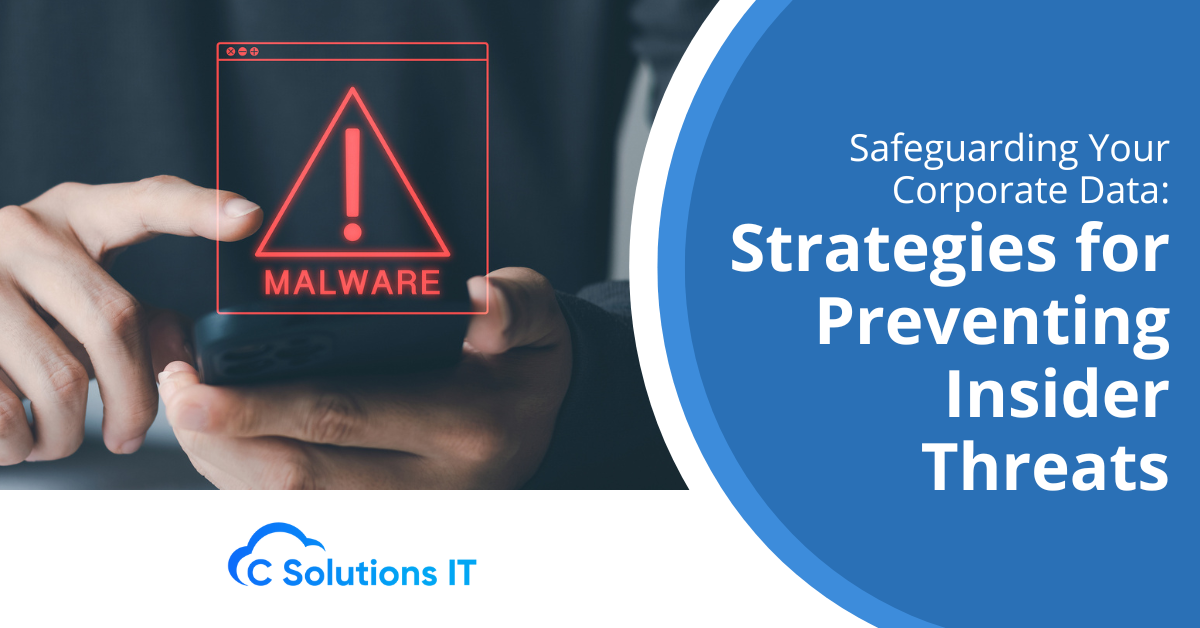Safeguarding Your Corporate Data: Strategies for Preventing Insider Threats

Businesses are more vulnerable to cyber threats today than ever before. While external threats such as malware and hacking are well-known risks, many companies fail to consider the dangers posed by insiders. Insider threats can come from current or former employees, contractors, vendors, or other trusted individuals who have access to your company’s data.
Insider threats account for over half of all data breaches, contributing to significant costs for businesses. In this article, we’ll explore strategies for preventing insider threats and safeguarding your corporate data.
Over the last two years, the volume of insider security incidents has increased by 44%.
Establish Clear Policies and Procedures
The first step in preventing insider threats is to establish clear policies and procedures for data access and handling. This includes defining roles and responsibilities, specifying access levels, and outlining acceptable use policies. All employees should be trained on these policies and provided with clear guidelines for accessing and handling sensitive data.
To reinforce these policies, it’s important to regularly monitor and audit access to sensitive data. This can include tracking logins and user activity, conducting regular security assessments, and reviewing access permissions to ensure they align with current business needs.
Implement Access Controls
Access controls are critical for preventing insider threats. This includes implementing least privilege access, which means granting users the minimum level of access necessary to perform their job functions. For example, if an employee does not need access to customer data, they should not be granted access to it.
In addition, to least privilege access, other access controls to consider include multi-factor authentication, role-based access controls, and network segmentation. These controls can help ensure that only authorized users can access sensitive data, even if a username and password are compromised.
Monitor for Unusual Activity
One of the most effective ways to prevent insider threats is to monitor for unusual activity. This includes monitoring user behavior and system activity for signs of malicious or suspicious behavior. Suspicious behavior can be anything from large file transfers and unauthorized access attempts to changes in access permissions.
By monitoring for unusual activity, you can detect insider threats early and take action before significant damage is done. It’s important to establish protocols for responding to potential incidents, including procedures for investigating incidents and reporting to law enforcement if necessary.
Conduct Regular Security Awareness Training
Insider threats can come from unintentional actions, such as accidentally clicking on a phishing link or downloading malware. That’s why it’s important to conduct regular security awareness training for all employees. This training should include best practices for password management, phishing awareness, and safe web browsing.
By educating employees on the risks of insider threats and how to prevent them, you can reduce the likelihood of a breach occurring. It’s also important to reinforce this training regularly and make it a part of the company culture.
Protect Data at Rest and in Transit
Protecting data at rest and in transit is critical for preventing insider threats. This includes encrypting sensitive data both at rest and in transit, using secure protocols for file transfers, and implementing data loss prevention (DLP) solutions to prevent data leakage.
Along with encryption and DLP, it’s important to regularly back up your data to prevent data loss in the event of a breach or other disaster. Backup data should be encrypted and stored in a secure offsite location.
Take Action Against Insider Threats
Insider threats are a growing concern for businesses of all sizes. By establishing clear policies and procedures, implementing access controls, monitoring for unusual activity, conducting regular security awareness training, and protecting data at rest and in transit, you can significantly reduce the risk of an insider-related breach occurring.
While there is no foolproof way to prevent all cyber threats, following these best practices can go a long way in safeguarding your corporate data. It’s important to regularly assess your security posture and adjust your strategies as needed to stay ahead of evolving threats.
You should also have a response plan in place in case of a security incident. This includes protocols for identifying and containing the incident, assessing the damage, and communicating with stakeholders. By having a procedure in place ahead of time, you can minimize the impact of a breach and get back to business as quickly as possible.
It’s also worth noting that while insider threats are a serious concern, not all insider-related incidents are malicious in nature. Accidental data breaches can occur due to human error, such as sending an email to the wrong recipient or misplacing a device containing sensitive data. That’s why it’s essential to have policies and procedures in place to prevent these types of incidents as well.
At C Solutions IT, we understand that preventing insider threats requires a multi-layered approach that includes policies and procedures, access controls, monitoring, training, and data protection.
We can assist you in taking a proactive approach to security so you can significantly reduce the risk of a breach occurring and protect your corporate data from malicious insiders. Contact us today to assess your current security posture and implement procedures to stay ahead of evolving threats with our comprehensive IT services.
